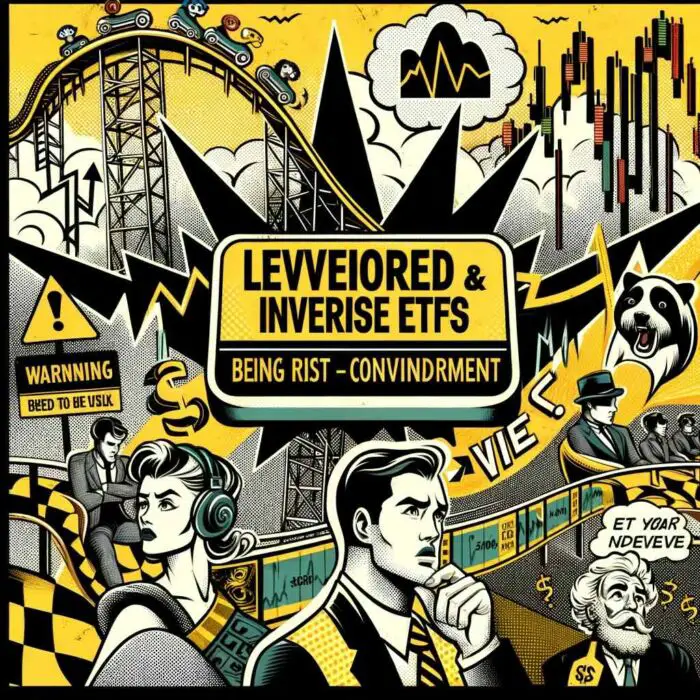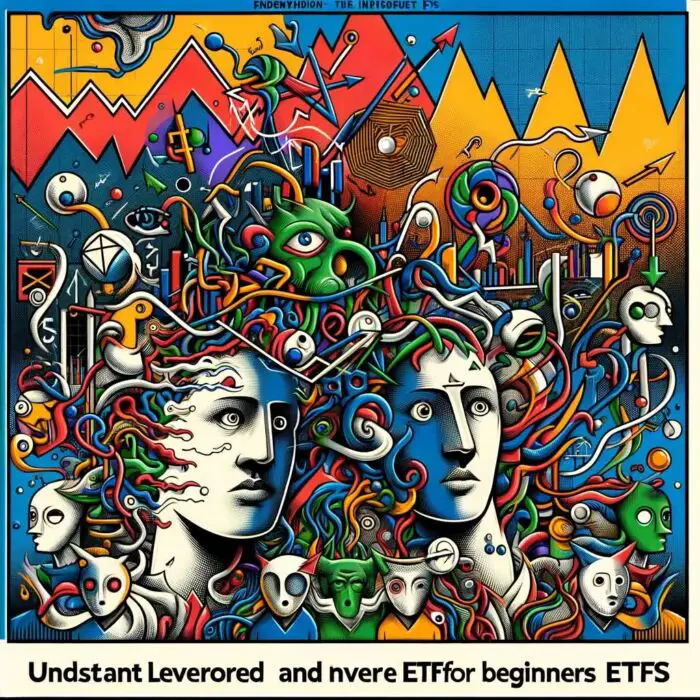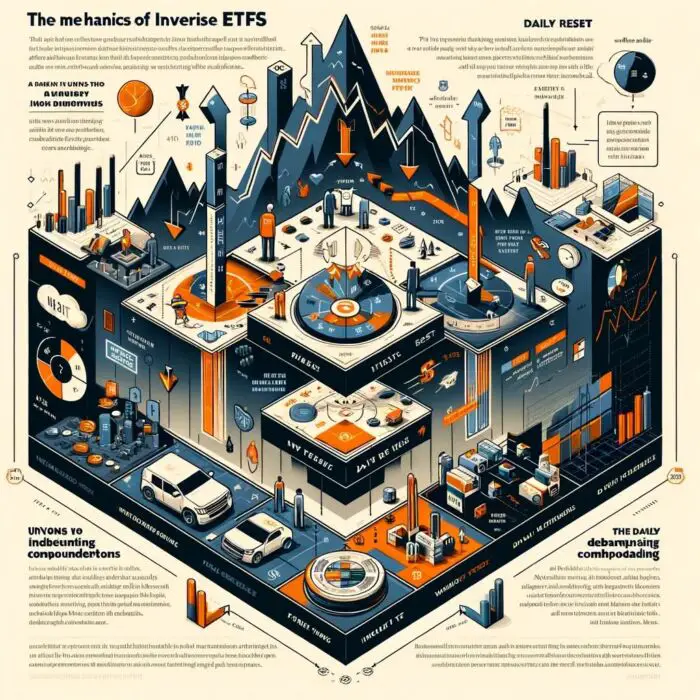As we dip our toes into the vast ocean of finance, one of the first life rafts we encounter is the Exchange-Traded Fund, or ETF as it’s affectionately known. An ETF is a sort of hybrid creature, blending the traits of individual stocks and traditional mutual funds. Like a chameleon, it can change its color, reflecting a diverse array of asset classes – be it stocks, bonds, commodities, or even a blend of these. It trades on an exchange just like a stock, and like a mutual fund, it offers you a way to invest in a broad market sector or economy without having to buy each individual security within it.

Introduction to Leveraged and Inverse ETFs
Just when you thought you had ETFs figured out, enter their more complex cousins: leveraged and inverse ETFs. These creatures of the financial jungle are not for the faint-hearted. Leveraged ETFs aim to deliver a multiple of the daily performance of the index or benchmark they track. On the other hand, inverse ETFs strive to achieve the opposite of the daily performance of their chosen index. Think of it as a mirror reflecting a reverse image, or a bungee jumper propelled in the opposite direction of gravity!

Importance of Understanding Leveraged and Inverse ETFs for Beginners
Despite their appeal, leveraged and inverse ETFs can be as tricky as a greased pig at a county fair. Their complexity and the risks associated with them make it essential for any beginner venturing into their territory to understand them inside out.
Consider this your cautionary tale, dear reader. As we journey together through the exciting but potentially treacherous landscape of leveraged and inverse ETFs, I implore you to keep your eyes wide open and your wits about you. Remember, understanding these complex financial instruments is like mastering the sword before heading into battle. And master it we shall, for the world of leveraged and inverse ETFs awaits us!

Understanding Exchange-Traded Funds (ETFs)
An Exchange-Traded Fund (ETF), in its simplest form, is a basket of securities – it could contain stocks, bonds, commodities, or a mix of investment assets – that you can buy or sell through a brokerage firm on a stock exchange. Think of it like a shopping basket filled with your favorite goodies, except here, the goodies are financial assets, and the supermarket is the stock exchange.
Just like individual stocks, ETFs have ticker symbols and their price fluctuates throughout the trading day as they’re bought and sold. But behind the scenes, the creation and redemption of ETF shares involve a tango between various players – the ETF provider, authorized participants (often large institutional investors), and the individual investors like you and me.
Types of ETFs
If variety is the spice of life, then ETFs are certainly spicing up the investment world. The realm of ETFs is teeming with different species, each tailored to meet diverse investment goals.
There are broad-market ETFs, like those tracking the S&P 500, which are like wide-angle lenses capturing the whole market. Then there are sector ETFs, focusing on specific industries such as technology, healthcare, or finance – these are akin to the zoom lenses of the investment world. Country ETFs let you globetrot across different economies from the comfort of your home. Bond ETFs are your ticket to the world of fixed-income securities, while commodity ETFs let you own a piece of precious metals, oil, or agricultural products. Then there are the thematic ETFs that concentrate on particular trends or concepts like environmental sustainability or artificial intelligence.

Advantages and Disadvantages of Investing in ETFs
Investing in ETFs comes with its pros and cons. On the upside, ETFs offer diversification. Since each ETF holds a variety of assets, you get to spread your eggs across multiple baskets, reducing the risk tied to any single security. They also offer transparency; you can easily see what assets are in the ETF and in what proportion. Add to that their liquidity – being able to buy and sell them like stocks during the trading day – and you’ve got an enticing investment vehicle.
However, there’s no such thing as a free lunch in the financial world. ETFs come with their share of downsides. They carry expense ratios, which are the costs to manage and operate the fund. While these are generally lower than mutual funds, they can still eat into your returns. Plus, while diversification can be a boon, it can also dilute the impact of standout performers. Also, because they can be bought and sold throughout the day, ETFs might tempt investors into excessive trading, potentially racking up transaction costs and veering into the risky realm of speculation.
Like any investment, ETFs are not a one-size-fits-all solution. They’re tools in your financial toolbox. The key is understanding how and when to use them. Now that we’ve got a grasp on ETFs, let’s dare to delve deeper into the adventurous arena of leveraged and inverse ETFs.

Deep Dive into Leveraged ETFs
If ETFs are regular cars driving you towards your investment destination, then leveraged ETFs are the sports cars designed to get you there faster. As the name suggests, leveraged ETFs employ leverage – essentially borrowed capital – with the aim of magnifying the daily returns of an underlying index or benchmark. They promise a return that is a multiple of the index’s return. So, a 2x leveraged ETF aims to provide twice the daily index return, while a 3x leveraged ETF seeks to triple it. But remember, with great speed comes great risk!

How Leveraged ETFs Work
Here’s where we roll up our sleeves and pop open the hood of leveraged ETFs. To achieve their goal, these ETFs use financial derivatives and debt to amplify the returns of the underlying index. These are the turbochargers boosting the ETF’s performance.
But there’s a twist in the plot: leveraged ETFs reset their leverage daily, meaning they rebalance their assets every day to maintain the stated level of leverage. This leads to what is known as the “compounding effect,” which can cause the ETF’s performance to deviate from the expected return over longer periods. Because of this, leveraged ETFs are typically more suited for short-term trading rather than long-term investing.
source: Wall Street Millennial on YouTube
Examples of Popular Leveraged ETFs
To bring this to life, let’s consider a couple of examples. The ProShares UltraPro QQQ (TQQQ) is a popular leveraged ETF that seeks to deliver three times the daily performance of the NASDAQ-100 Index. This ETF invests in large-cap growth stocks like Apple, Microsoft, and Amazon, and uses leverage to enhance its daily returns.
Similarly, the Direxion Daily Financial Bull 3x Shares (FAS) aims to provide three times the daily performance of the Russell 1000 Financial Services Index. This leveraged ETF holds a range of financial stocks and is another example of the turbo-charged vehicles in the world of leveraged ETFs.
But hold onto your hats! Just as these funds can accelerate your profits on a good day, they can also intensify your losses when the market goes the other way. Remember, the fast lane isn’t for everyone. If you can’t stomach a wild ride, you may want to stick to the slower, but steadier, lanes of the investment highway.
source: Optimized Portfolio on YouTube
Deep Dive into Inverse ETFs
If leveraged ETFs are the sports cars of the investing world, inverse ETFs are the time machines, often zipping you back in time when things were better. But don’t pack your bags for a nostalgic journey just yet! Inverse ETFs, also known as short or bear ETFs, are designed to profit from a decline in the value of an underlying benchmark. They seek to deliver the opposite of the performance of the index or benchmark they track. In a sense, they’re the contrarians of the ETF world, prospering when others falter.

How Inverse ETFs Work
The mechanics underpinning inverse ETFs are intriguing. These funds use various derivatives, mainly swaps, futures contracts, and other exotic financial instruments, to achieve their goal. Here’s the fascinating bit: when the index falls, these inverse ETFs rise by roughly the same percentage (minus fees and expenses), and vice versa.
However, like their leveraged cousins, inverse ETFs also reset daily, meaning they aim to achieve their stated objectives on a daily basis. This leads to the effects of daily compounding which can result in the fund’s performance deviating from the inverse of the index’s return over longer periods. Thus, while they might appear as a lucrative bet during a downturn, they are typically more suited for short-term trading than for long-term buy-and-hold strategies.

Examples of Popular Inverse ETFs
To translate this into real-world scenarios, let’s peek at some actual inverse ETFs. The ProShares Short S&P500 (SH) is designed to move in the opposite direction of the S&P 500 index. On a day when the S&P 500 index drops by 1%, SH aims to increase by approximately 1%, before fees and expenses.
Similarly, the ProShares UltraPro Short QQQ (SQQQ) is an inverse leveraged ETF that aims to return three times the inverse of the daily performance of the NASDAQ-100 index.
But tread carefully! While these contrarian instruments can provide substantial gains during market downturns, they can also rack up significant losses during market upswings. Like trying to swim against the tide, profiting when markets fall can be tricky and is generally best left to more experienced investors. The world of inverse ETFs is full of thrills and spills, and it’s vital to understand the ride before you buy the ticket.

Risks of Leveraged and Inverse ETFs
For thrill-seekers, the roller-coaster rides at amusement parks might be exciting, but when those heart-stopping highs and stomach-churning drops happen to your investment portfolio, the experience is anything but fun
High Volatility and Potential for Significant Losses
Leveraged and inverse ETFs are known for their high volatility – they can zoom towards the stars or plummet into an abyss depending on the market swings. This amplified sensitivity can lead to significant losses, especially during volatile markets.
The higher the leverage, the higher the potential returns, but also the steeper the potential falls. Think of it as sliding down a slope: the steeper the slope (or the higher the leverage), the faster and potentially more uncontrollable your descent. While it might sound adventurous, the ride might not be as enjoyable when your hard-earned money is at stake.
Impact of Daily Reset on Long-Term Performance
The daily reset feature of leveraged and inverse ETFs can be as deceptive as a siren’s song. On the surface, the prospect of doubling or even tripling daily returns, or profiting from a market downturn, can be alluring. But the daily reset can cause the performance of these ETFs to drift apart from the multiple of the index returns over longer periods due to the compounding effect.
The resetting is like a game of tug-of-war where you’re always pulled back to the starting line. It might seem as if you’re not getting anywhere, especially during periods of market volatility. For long-term investors seeking consistent performance relative to an index, this can be frustrating and potentially detrimental.

Risks Associated with Derivative Investments
Leveraged and inverse ETFs use financial derivatives to achieve their amplified returns, like a chef using spices to create a zesty dish. But just as too many spices can spoil the dish, over-reliance on derivatives can increase the risk of these ETFs.
Derivatives are complex financial instruments that derive their value from an underlying asset, hence the name. They can be as unpredictable as a cat on a hot tin roof, and their prices can fluctuate drastically due to changes in the value of the underlying asset, interest rates, or market volatility. Furthermore, there’s the counterparty risk – the risk that the party on the other end of a derivative contract won’t fulfill their obligations, potentially leading to losses.
Leveraged and inverse ETFs are like spices in the world of investing. Used judiciously, they can add zest to your portfolio. But used imprudently, they can lead to a financial heartburn. It’s essential to understand these risks before taking a bite of this spicy investment delicacy.
source: The Plain Bagel on YouTube
Who Should Consider Investing in Leveraged and Inverse ETFs
In the grand opera of investing, leveraged and inverse ETFs are the high notes – thrilling, intense, but certainly not for everyone. They fit best in the repertoire of active traders who have their fingers on the pulse of the market and can nimbly navigate the high-voltage trading these ETFs require. They’re the financial equivalents of speed chess, where quick decisions and constant vigilance are critical.
Investors with a sound understanding of how derivatives work, the implications of daily resetting, and the gumption to stomach potentially significant volatility may find these tools useful. These seasoned maestros can use leveraged and inverse ETFs to hedge their portfolio, exploit market trends, or capitalize on short-term market fluctuations.

Not Ideal for Long-Term, Passive Investors
On the other end of the spectrum, long-term, passive investors are like landscape photographers: they set up their equipment, find their focus, and wait patiently for the perfect shot. For these investors, the frenzy of leveraged and inverse ETFs may seem like trying to photograph a speeding train – it’s stressful, potentially blurry, and could lead to missed opportunities.
The daily rebalancing and the potential performance drift over time make these ETFs unsuitable for a buy-and-hold strategy. It’s like planting a tree in a pot instead of the ground – it may not have enough room to grow and thrive over the long term.

Importance of Risk Tolerance and Financial Goals in Deciding to Invest
Deciding whether to dip your toes into the choppy waters of leveraged and inverse ETFs isn’t just a question of skills and experience – it’s also about looking inwards. Do you have the risk tolerance to handle the potential high volatility and losses? Are your financial goals aligned with short-term, high-risk trading?
It’s essential to weigh these factors carefully. You don’t want to sign up for a bungee jump only to realize at the top that you’re afraid of heights. A thorough understanding of your financial situation, investment goals, and risk appetite is paramount before venturing into this high-risk, high-reward segment of the investment universe.
After all, investing isn’t just about making money – it’s about making money in a way that aligns with your life, your goals, and your peace of mind.

Tips for Investing in Leveraged and Inverse ETFs
Investing in leveraged and inverse ETFs without ample research is akin to crossing a busy intersection with your eyes closed—it’s simply not advisable. You need to understand the traffic patterns, the speed of vehicles, and of course, the color of the traffic lights! Similarly, a deep dive into the inner workings of these complex instruments is vital.
Reading the fund’s prospectus is a good starting point, as it provides information about the ETF’s objectives, strategies, and associated costs. Furthermore, study the underlying index and the ETF’s historical performance. But remember, like a speedometer that tells you how fast you’re going but not where you’re headed, historical performance is no predictor of future results. It’s important to supplement this with understanding broader market conditions and trends.
Monitoring Investments Closely
Investing in leveraged and inverse ETFs is not a ‘set-and-forget’ type of investment. They’re more like delicate soufflés that require constant attention to ensure they don’t fall flat. Given their high volatility and daily reset feature, these ETFs warrant close monitoring. Staying attuned to market trends and adjusting positions accordingly is crucial.
Think of it like navigating a sailboat: you can’t control the wind, but you can adjust the sails. By regularly tracking your investments, you can respond to market shifts and hopefully prevent your financial ship from capsizing.

Importance of Diversification and Risk Management
The adage “don’t put all your eggs in one basket” holds particularly true for investing in leveraged and inverse ETFs. They can be spicy additions to your investment meal but should not be the main course. Having a diversified portfolio helps spread risk and can buffer against potential losses from these volatile instruments.
Risk management measures like setting stop-loss orders or using protective options strategies could also be beneficial. It’s like putting on sunscreen before a beach day—you hope you won’t get burnt, but it’s better to be safe than sorry.
Remember, investing should be a marathon, not a sprint. The goal is not to get rich quick but to build wealth steadily over time. Leveraged and inverse ETFs can have a place in your portfolio, but they need to be used judiciously and in alignment with your overall investment strategy. Because at the end of the day, it’s not just about how much money you make, but also how well you sleep at night.

Conclusion: Leveraged and Inverse ETFs
Ladies and gentlemen, we’ve been on quite a journey exploring the fascinating yet precarious terrain of leveraged and inverse ETFs. These financial instruments, with their power to amplify returns or provide gains when markets fall, can indeed be enticing. They’re like the superheroes of the investment world, promising superhuman feats in comparison to their more pedestrian counterparts.
But just like superheroes, they come with their unique vulnerabilities. The kryptonite for these ETFs? Their high volatility, daily reset feature, and reliance on complex derivatives can quickly turn the tables on their performance. They’re not for the faint-hearted and require vigilance, resilience, and a firm grip on your financial steering wheel.
B. Encouragement for Further Education and Careful Consideration Before Investing in These Complex Instruments
Remember, dear reader, that knowledge is your most potent weapon and shield in the financial realm. Investing in leveraged and inverse ETFs is no child’s play—it’s a game best suited for experienced players who have done their homework, understand the rules, and are prepared for a wild ride.
If you’re considering adding these exotic creatures to your financial zoo, I urge you to immerse yourself in further education about these instruments. Speak to financial advisors, participate in investment seminars, read extensively, and do not shy away from asking questions. The world of investing is a generous teacher—there are lessons in its successes, and perhaps even more in its failures.
In conclusion, let me leave you with this thought: investing isn’t a gamble or a guessing game—it’s a strategic move towards your financial goals. Whether leveraged and inverse ETFs align with your strategy is a decision only you can make, hopefully with wisdom, caution, and a well-made cup of coffee by your side. Because in the end, it’s not just about making money—it’s about making informed decisions, taking calculated risks, and ultimately, crafting the financial future you desire.
Important Information
Comprehensive Investment Disclaimer:
All content provided on this website (including but not limited to portfolio ideas, fund analyses, investment strategies, commentary on market conditions, and discussions regarding leverage) is strictly for educational, informational, and illustrative purposes only. The information does not constitute financial, investment, tax, accounting, or legal advice. Opinions, strategies, and ideas presented herein represent personal perspectives, are based on independent research and publicly available information, and do not necessarily reflect the views or official positions of any third-party organizations, institutions, or affiliates.
Investing in financial markets inherently carries substantial risks, including but not limited to market volatility, economic uncertainties, geopolitical developments, and liquidity risks. You must be fully aware that there is always the potential for partial or total loss of your principal investment. Additionally, the use of leverage or leveraged financial products significantly increases risk exposure by amplifying both potential gains and potential losses, and thus is not appropriate or advisable for all investors. Using leverage may result in losing more than your initial invested capital, incurring margin calls, experiencing substantial interest costs, or suffering severe financial distress.
Past performance indicators, including historical data, backtesting results, and hypothetical scenarios, should never be viewed as guarantees or reliable predictions of future performance. Any examples provided are purely hypothetical and intended only for illustration purposes. Performance benchmarks, such as market indexes mentioned on this site, are theoretical and are not directly investable. While diligent efforts are made to provide accurate and current information, “Picture Perfect Portfolios” does not warrant, represent, or guarantee the accuracy, completeness, or timeliness of any information provided. Errors, inaccuracies, or outdated information may exist.
Users of this website are strongly encouraged to independently verify all information, conduct comprehensive research and due diligence, and engage with qualified financial, investment, tax, or legal professionals before making any investment or financial decisions. The responsibility for making informed investment decisions rests entirely with the individual. “Picture Perfect Portfolios” explicitly disclaims all liability for any direct, indirect, incidental, special, consequential, or other losses or damages incurred, financial or otherwise, arising out of reliance upon, or use of, any content or information presented on this website.
By accessing, reading, and utilizing the content on this website, you expressly acknowledge, understand, accept, and agree to abide by these terms and conditions. Please consult the full and detailed disclaimer available elsewhere on this website for further clarification and additional important disclosures. Read the complete disclaimer here.





